Description
Why feature a mayfly pattern during the
winter months, you ask? That’s certainly a
legitimate question. But the answer is
simple: Baetis mayflies hatch regularly
during most of the year, including winter.
We non-scientific anglers call this
diminutive insect a “blue winged olive.”
Graceful in their appearance, and muted in
their subtle coloration, these lovely little
fellows wane in their size as the season
progresses: From about ¼” in the spring to
1/8” or smaller in late fall and early
winter.
Set forth below is an excerpt taken from the
following TroutNut.com web page:
http://www.troutnut.com/hatch/180/Mayfly-Baetis-Blue-Winged-Olives
“Baetis
nymphs are normally outstanding swimmers,
but they are reported to lose this ability
when they emerge. They get to the surface
buoyed by gas bubbles, or by crawling to the
surface on some object and letting go to
drift along in the film (rather than
crawling out). They have trouble breaking
through the surface film, escaping their
shucks (
and drying their wings to take flight, which
means that almost any type of surface fly
has its uses. The
Baetis
angler may need to use deep nymphs, floating
nymphs, emerger)
patterns, or dun patterns during this
emergence. Common wisdom says floating nymph
and emerger patterns are the most useful. Dismal weather invites the best
hatches of
Baetis
mayflies; look for them on overcast, rainy
days, as long as the water temperature is
above 40°F.”
The
www.Troutnut.com website is a powerhouse
of information on aquatic insects; articles
are often accompanied by excellent images
such as these two of a Baetis dun and
nymph:
This month’s pattern is called a “cripple”.
I am often asked the following question:
What is a “cripple” and how does it differ
from an “emerger”? Again from the
Troutnut.com web site: “In
fly fishing, a cripple is any insect which
has been injured or deformed so that it
cannot escape the water. This may include
stillborn emergers or fully emerged adults
which have been damaged, often by wind or
waves, so that they can no longer fly. Trout
often favor eating crippled insects.”
Personally I take a
practical approach: For fishing purposes,
the difference between the two terms is of
little significance. Patterns we call
“emergers” can be used to imitate
“cripples.” The pattern I have selected for
this month is generic enough in appearance
to bridge the gap and accomplish our aim: To
fool our beloved prey. The Baetis Cripple
pattern belongs to Bob Quigley, the guru of
spring creek fly angling (especially his
home water, the Fall River). It floats well,
uses readily available materials, and is
visible despite its tiny size.
Tying Instructions
|
|
1. Smash the barb
and cover the hook with a layer of thread,
leaving the bobbin to hang just below the
back of the barb.
2. Cut a small
bunch of relatively long pheasant tail
fibers and tie them in a just above the back
of the barb. Don’t trim the butts as they
are used in the next step. |
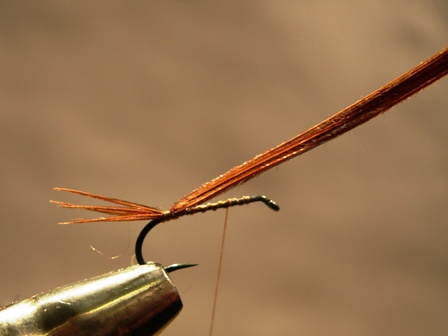 |
|
|
|
|
3. Wind the butts
of the pheasant tail fibers 2/3 of
the way up the hook shank and tie
them off there. |
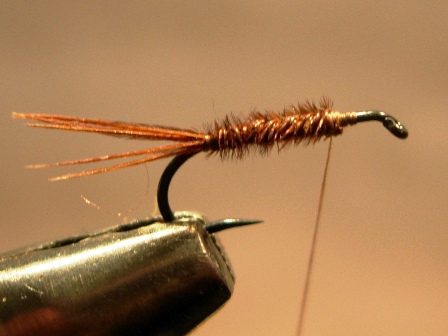 |
|
|
|
|
4. Dub a small thorax in front of
the abdomen, leaving enough room to
mount the wing and hackle in front
of it. |
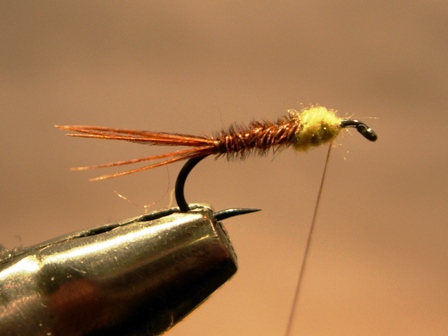 |
|
|
|
|
5. Cut a small bunch of tan deer
hair, stack it, and tie it ahead of
the thorax with the tips extending
out over the eye of the hook. This
will be the cripple’s wing. The
length of the wing should be
approximately equal to the hook
shank. Trim the hair butts, leaving
a small visible butt; this is done
to resemble the remains of the
nymph’s wing case. Place a tiny drop
of super glue on the wraps.
|
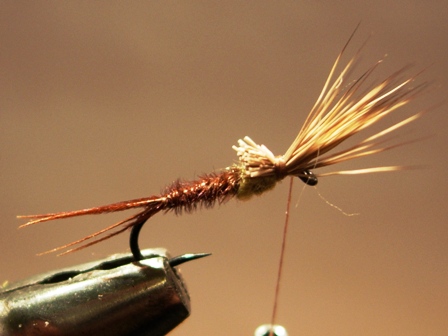 |
|
|
|
|
6. Prepare a
properly sized hackle and tie it in
on the wraps taken for the wing.
Wrap the hackle 3 or 4 times around
the shank and tie it off.
7. Whip finish in
front of the wing, behind the eye, and
trim the thread. Add a tiny drop of
super glue to the threads.
|
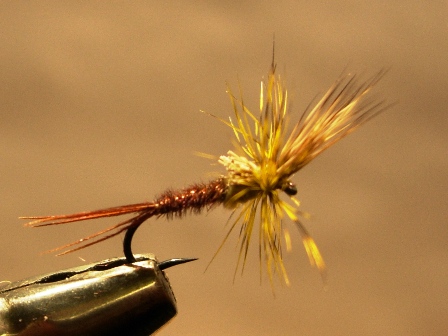 |
|
|
|
|
Tying Tips
1.
Tie these bugs in different sizes, from #16
to #22.
2.
When fishing the
Baetis Cripple, put floatant only on the deer hair and hackle; the rest
of the fly should be submerged and therefore needs to be free of floatant.
Consequently, you should not use desiccant/silicone powders with this pattern.
3.
If you want the
bug to fish slightly subsurface, then add some copper wire ribbing to the
abdomen.
4.
Don’t forget to
also have some Baetis dun patterns (e.g., Parachute Adams) and nymphs
(e.g., Pheasant Tail Nymphs).
Go crank
some of these bugs, fool some trout with them, and…
|
|
|
|
|
 |
|